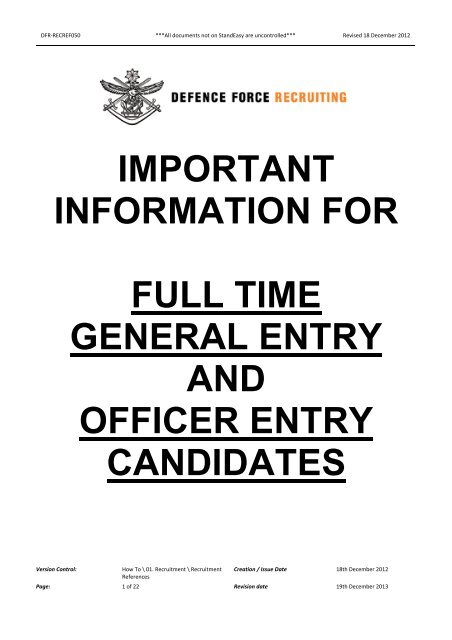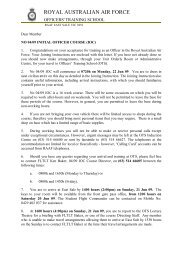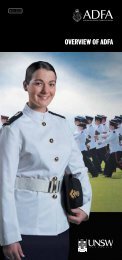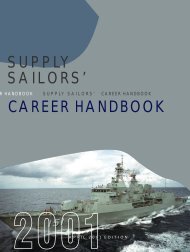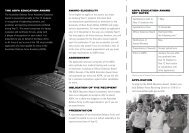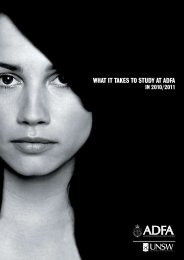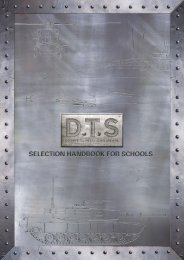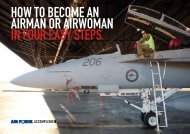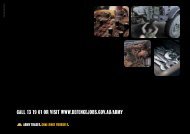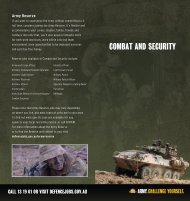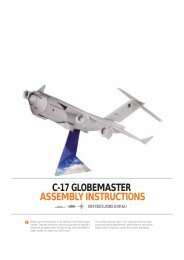DFR-RECREF050 Important Information for General Entry and ...
DFR-RECREF050 Important Information for General Entry and ...
DFR-RECREF050 Important Information for General Entry and ...
You also want an ePaper? Increase the reach of your titles
YUMPU automatically turns print PDFs into web optimized ePapers that Google loves.
<strong>DFR</strong>-<strong>RECREF050</strong> ***All documents not on St<strong>and</strong>Easy are uncontrolled*** Revised 18 December 2012<br />
IMPORTANT<br />
INFORMATION FOR<br />
FULL TIME<br />
GENERAL ENTRY<br />
AND<br />
OFFICER ENTRY<br />
CANDIDATES<br />
Version Control:<br />
How To \ 01. Recruitment \ Recruitment<br />
References<br />
Creation / Issue Date 18th December 2012<br />
Page: 1 of 22 Revision date 19th December 2013
<strong>DFR</strong>-<strong>RECREF050</strong> ***All documents not on St<strong>and</strong>Easy are uncontrolled*** Revised 18 December 2012<br />
THE FOLLOWING INFORMATION IS APPLICABLE TO ALL CANDIDATES (OFFICER or GENERAL<br />
ENTRY)................................................................................................................................................................... 4<br />
Motivation ........................................................................................................................................................ 4<br />
Ask yourself the following................................................................................................................................ 4<br />
Detailed preparation ........................................................................................................................................ 4<br />
Know the following .......................................................................................................................................... 4<br />
What will make you more competitive............................................................................................................. 4<br />
<strong>In<strong>for</strong>mation</strong> Required <strong>for</strong> the Defence Interview at your Assessment Session............................................... 5<br />
Speaking with your Defence Interviewer......................................................................................................... 5<br />
THE FOLLOWING INFORMATION IS APPLICABLE TO OFFICER ENTRY CANDIDATES ONLY .................. 6<br />
Additional areas examined in the Defence Interview: ..................................................................................... 6<br />
Your ability to lead others <strong>and</strong> communicate effectively ................................................................................. 6<br />
The Officer Selection Board (OSB) ................................................................................................................. 6<br />
To help you prepare <strong>for</strong> the OSB .................................................................................................................... 7<br />
Useful Websites <strong>for</strong> Officer <strong>Entry</strong> Preparation ................................................................................................ 7<br />
THE FOLLOWING INFORMATION IS APPLICABLE TO GENERAL ENTRY CANDIDATES ONLY................. 8<br />
Recruit Training Establishments ..................................................................................................................... 8<br />
Army Basic Training - Kapooka....................................................................................................................... 8<br />
Navy Basic Training - HMAS Cerberus........................................................................................................... 9<br />
RAAF Basic Training – RAAF Base Wagga.................................................................................................. 10<br />
Useful Websites <strong>for</strong> <strong>General</strong> <strong>Entry</strong> Preparation ............................................................................................ 11<br />
IMPORTANT REQUIREMENTS OF ADF SERVICE – POLICIES AND CONDITIONS ..................................... 12<br />
Operational Service....................................................................................................................................... 12<br />
Sea Service ................................................................................................................................................... 12<br />
Defence Force Discipline Act ........................................................................................................................ 12<br />
Military Discipline System.............................................................................................................................. 12<br />
Unrestricted Service ...................................................................................................................................... 13<br />
Service Allowance ......................................................................................................................................... 13<br />
Interdependent relationships <strong>and</strong> partner’s employment .............................................................................. 13<br />
Military <strong>and</strong> Trade Skills ................................................................................................................................ 13<br />
Initial Minimum Period of Service (IMPS)...................................................................................................... 13<br />
Age Restriction .............................................................................................................................................. 13<br />
Gender Restrictions....................................................................................................................................... 14<br />
Postings <strong>and</strong> Deployments............................................................................................................................ 14<br />
Medical <strong>and</strong> Physical Fitness........................................................................................................................ 14<br />
HIV (AIDS) <strong>and</strong> other Viral Testing ............................................................................................................... 15<br />
Dress <strong>and</strong> Grooming St<strong>and</strong>ards.................................................................................................................... 15<br />
Body Embellishment restrictions ................................................................................................................... 15<br />
Regulation of Lifestyle ................................................................................................................................... 16<br />
Equity, Diversity <strong>and</strong> Unacceptable Behaviour ............................................................................................. 16<br />
Police <strong>and</strong> Security Checks........................................................................................................................... 16<br />
Criminal Record Offence History................................................................................................................... 16<br />
Pre-entry Medical Examination ..................................................................................................................... 16<br />
Drugs............................................................................................................................................................. 16<br />
Compulsory Drug Testing.............................................................................................................................. 16<br />
Alcohol........................................................................................................................................................... 16<br />
Per<strong>for</strong>mance Appraisal System..................................................................................................................... 16<br />
Return of Service Obligation (ROSO) ........................................................................................................... 17<br />
Training Failure ............................................................................................................................................. 17<br />
Conclusion..................................................................................................................................................... 17<br />
Version Control:<br />
How To \ 01. Recruitment \ Recruitment<br />
References<br />
Creation / Issue Date 18th December 2012<br />
Page: 2 of 22 Revision date 19th December 2013
<strong>DFR</strong>-<strong>RECREF050</strong> ***All documents not on St<strong>and</strong>Easy are uncontrolled*** Revised 18 December 2012<br />
CONDITIONS AND BENEFITS OF SERVICE (HOUSING, LEAVE etc.)........................................................... 17<br />
Leave Entitlements........................................................................................................................................ 17<br />
Long Service Leave....................................................................................................................................... 17<br />
Annual Leave Free Travel............................................................................................................................. 18<br />
Leave Travel <strong>for</strong> Trainees ............................................................................................................................. 18<br />
Medical <strong>and</strong> Dental Treatment ...................................................................................................................... 18<br />
Accommodation Assistance .......................................................................................................................... 18<br />
Further Education <strong>for</strong> Serving Members ....................................................................................................... 19<br />
Removals....................................................................................................................................................... 20<br />
Posting Policy................................................................................................................................................ 20<br />
FITNESS STANDARDS REQUIRED FOR ENTRY INTO THE ADF................................................................... 20<br />
Army .............................................................................................................................................................. 20<br />
Air Force........................................................................................................................................................ 20<br />
Navy .............................................................................................................................................................. 21<br />
F88 STEYR........................................................................................................................................................... 22<br />
Version Control:<br />
How To \ 01. Recruitment \ Recruitment<br />
References<br />
Creation / Issue Date 18th December 2012<br />
Page: 3 of 22 Revision date 19th December 2013
<strong>DFR</strong>-<strong>RECREF050</strong> ***All documents not on St<strong>and</strong>Easy are uncontrolled*** Revised 18 December 2012<br />
THE FOLLOWING INFORMATION IS APPLICABLE TO ALL CANDIDATES<br />
(OFFICER or GENERAL ENTRY)<br />
This article provides you with some practical advice that will assist you through the selection process. If you<br />
are seriously thinking about a career with the Australian Defence Force, then read on.<br />
Motivation is a major point which will be evaluated in detail by each of the interviewers during the recruitment<br />
process. You must be well prepared <strong>and</strong> learn everything you can about the roles <strong>and</strong> responsibilities of the<br />
position you are applying <strong>for</strong>. As a c<strong>and</strong>idate, expect the interviewer to ask questions aimed at satisfying<br />
themselves on these issues.<br />
Ask yourself the following:<br />
• Do I really want to be a soldier, sailor, airman / airwoman or officer?<br />
• Why do I want to be a soldier, sailor, airman / airwoman or officer?<br />
• Do I have the right academic qualifications <strong>and</strong> personal traits to be become a soldier, sailor, airman/<br />
airwoman or officer?<br />
• Do I know the role <strong>and</strong> can I cope with the responsibilities?<br />
• Do I know the training process?<br />
• How much do I know about military life in general?<br />
• How will my lifestyle be affected by joining the Defence Force?<br />
• Do I underst<strong>and</strong> the enlistment/appointment conditions of service?<br />
• What does my family or partner think about my application?<br />
• Can I offer unrestricted service? (see page 3 <strong>for</strong> more in<strong>for</strong>mation)<br />
Detailed preparation is necessary <strong>and</strong> you must learn as much as you can about the Defence Force <strong>and</strong> the<br />
particular service <strong>and</strong> position you are applying <strong>for</strong>. To be more competitive, each c<strong>and</strong>idate should attempt<br />
to speak with a current serving Defence member in the same service <strong>and</strong> position where you are seeking a<br />
position. The educational st<strong>and</strong>ard required is the minimum acceptable. <strong>Important</strong>ly, do not <strong>for</strong>get your<br />
application is considered in competition with others on a national basis. Good academic results are not the<br />
only factor considered when selecting applicants <strong>for</strong> entry.<br />
Know the following:<br />
• The training required to qualify in your job, including initial military training (IMT) <strong>and</strong> initial employment<br />
training (IET)<br />
• The role <strong>and</strong> job description in detail <strong>and</strong> in your own words.<br />
• The base locations relevant to your job <strong>and</strong> the basic types of equipment you will be using.<br />
• Underst<strong>and</strong> why you want the role <strong>and</strong> that particular service.<br />
• The role of an officer <strong>and</strong> have an underst<strong>and</strong>ing of what leadership is (officer applicants only).<br />
What will make you more competitive:<br />
• Motivation <strong>and</strong> attitude <strong>for</strong> study<br />
• Research your subject<br />
• Ambition <strong>and</strong> career knowledge<br />
• Per<strong>for</strong>mance at your interview<br />
• Enthusiasm<br />
Version Control:<br />
How To \ 01. Recruitment \ Recruitment<br />
References<br />
Creation / Issue Date 18th December 2012<br />
Page: 4 of 22 Revision date 19th December 2013
<strong>DFR</strong>-<strong>RECREF050</strong> ***All documents not on St<strong>and</strong>Easy are uncontrolled*** Revised 18 December 2012<br />
<strong>In<strong>for</strong>mation</strong> Required <strong>for</strong> the Defence Interview at your Assessment Session<br />
As part of the selection process you will be required to undertake an interview with a Defence Interviewer.<br />
You should know the answers to the following:<br />
• Where <strong>and</strong> how long is your initial military training (IMT) training?<br />
• What will you learn at basic/ officer training <strong>and</strong> what will the training environment be like?<br />
• Where <strong>and</strong> how long is your initial employment training (IET)?<br />
• What type of equipment might you use?<br />
• How long will you enlist/appoint <strong>for</strong>?<br />
• Where are the military bases that you may be posted to after training?<br />
• What Corp (Army), Mustering/ Specialisation (Air Force), or Category (Navy) will you belong to?<br />
• What are the main functions of the role you are applying <strong>for</strong>? How is the combat role related to this?<br />
• What are the potential operating environments <strong>for</strong> your job role?<br />
• What are the employment conditions <strong>for</strong> this job role – positive <strong>and</strong> negative.<br />
• What are the pay entitlements <strong>for</strong> initial military training (IMT) / initial employment training (IET) <strong>and</strong><br />
once fully qualified?<br />
• What is the ADF policy on non-medical use of drugs?<br />
• What will Service life be like?<br />
• What is the Pre Enlistment Fitness Assessment?<br />
Please Note: The above questions are only a guide. It is the minimum st<strong>and</strong>ard of knowledge we expect you<br />
to have. It is in your best interest to study as much relevant in<strong>for</strong>mation as possible to prepare <strong>for</strong> the<br />
interview. There are a number of useful web sites contained throughout this document that will assist you in<br />
accessing this in<strong>for</strong>mation.<br />
Speaking with your Defence Interviewer<br />
This vital component of your Assessment Session is the opportunity you are given to demonstrate why you<br />
want to join the ADF <strong>and</strong> what you know about the job(s) you have applied <strong>for</strong>. The Defence Interviewer is a<br />
serving member of the ADF from any of the three services. They will determine your suitability - not only <strong>for</strong><br />
the job(s) you have applied <strong>for</strong> but also whether you can cope with the dem<strong>and</strong>ing requirements of ADF<br />
service. The interview is confidential <strong>and</strong> there is no set time limit. However, most interviews take between 30<br />
- 45 minutes.<br />
At the end of the interview, your Defence Interviewer will either recommend you <strong>for</strong> the job(s) you have<br />
applied <strong>for</strong> or provide advice <strong>and</strong> suggestions on areas you need to address to improve your competitiveness.<br />
The best advice to c<strong>and</strong>idates is to be honest <strong>and</strong> be yourself. If you get nervous, don't worry. There's no<br />
harm in telling your Defence Interviewer that you are nervous.<br />
The questions the Defence Interviewer will ask are varied <strong>and</strong> are in no particular order. Don't be concerned if<br />
you cannot answer all the questions, however the more prepared you are the more confidant you will be. The<br />
Defence Interviewer does not expect you to know everything word <strong>for</strong> word, particularly from the DefenceJobs<br />
website. Instead, concentrate on being able to express yourself in your own words. You are not being<br />
assessed on how well you can recite in<strong>for</strong>mation.<br />
Please Note: Some specialist <strong>General</strong> <strong>Entry</strong> jobs may be also be required to appear be<strong>for</strong>e a Selection Board<br />
e.g. Crew attendant, Security Police <strong>and</strong> Airborne Electronics Analyst. Refer to the Additional Requirements<br />
section of your job listing on the DefenceJobs website (www.defencejobs.gov.au) <strong>for</strong> more in<strong>for</strong>mation. The<br />
section below regarding Officer Selection Boards can also be used as a guide.<br />
Version Control:<br />
How To \ 01. Recruitment \ Recruitment<br />
References<br />
Creation / Issue Date 18th December 2012<br />
Page: 5 of 22 Revision date 19th December 2013
<strong>DFR</strong>-<strong>RECREF050</strong> ***All documents not on St<strong>and</strong>Easy are uncontrolled*** Revised 18 December 2012<br />
THE FOLLOWING INFORMATION IS APPLICABLE TO OFFICER ENTRY CANDIDATES ONLY<br />
Additional areas examined in the Defence Interview:<br />
Your ability to lead others <strong>and</strong> communicate effectively, both orally <strong>and</strong> in writing is an important part of<br />
being an Officer. Success on military courses <strong>and</strong> promotion examinations, as well as an Officer’s day-to-day<br />
per<strong>for</strong>mance, depends greatly on strong communication skills. Accordingly, your Interviewer will note carefully<br />
your conversational skills, the use of a wide vocabulary, correct sentence structure <strong>and</strong> grammar. Additionally,<br />
they will assess your underst<strong>and</strong>ing of leadership concepts <strong>and</strong> your experience <strong>and</strong> potential <strong>for</strong> leadership<br />
positions as an officer. This may include an assessment of:<br />
• Leadership positions you may have held<br />
• School appointments<br />
• Leadership camps<br />
• Public speaking<br />
• Community involvement<br />
• Team sports participation<br />
• <strong>General</strong> knowledge <strong>and</strong> underst<strong>and</strong>ing of current ADF operations (read national newspapers; read<br />
Defence newspapers)<br />
• Self confidence<br />
• Maturity<br />
The Officer Selection Board (OSB)<br />
If you intend to apply <strong>for</strong> entry as an Officer or <strong>for</strong> the Australian Defence Force Academy <strong>and</strong> successfully<br />
pass the YOU <strong>and</strong> Assessment sessions you will be required to appear be<strong>for</strong>e an Officer Selection Board<br />
(OSB). The OSB consists of a series of activities designed to test aspects such as leadership skills, teamwork<br />
<strong>and</strong> individual abilities as well as a range of challenging problem-solving exercises designed to test your<br />
competitiveness <strong>for</strong> available vacancies.<br />
The OSB usually consists of a number of activities including:<br />
• Oral presentation (RAAF c<strong>and</strong>idates only)<br />
• Outdoor Activity <strong>and</strong> Fitness Assessment (GSO ADFA/RMC/ARES Army only)<br />
• Formal interviews (all positions <strong>and</strong> Services <strong>for</strong> up to one hour)<br />
• Attend Pilot Selection Agency (PSA) <strong>for</strong> all avenues of entry Pilots / Observers.<br />
The <strong>for</strong>mal interviews will be conducted be<strong>for</strong>e a panel of Officers usually including:<br />
• President (Military Person)<br />
• Specialist Officer (Military Person)<br />
• Psychologist<br />
The OSB will offer you the opportunity to make a favourable impression upon the Board. Board members will<br />
make allowances <strong>for</strong> applicants who are nervous <strong>and</strong> will do their best to put them at ease however they will<br />
expect you to overcome <strong>and</strong> control nervousness <strong>and</strong> present yourself in the most favourable light.<br />
The following are points <strong>for</strong> you to consider to improve your presentation:<br />
• Pay careful attention to dress <strong>and</strong> grooming. First impressions are important.<br />
• Be quietly confident <strong>and</strong> sell yourself. Answer all questions fully <strong>and</strong> completely. Think be<strong>for</strong>e you<br />
speak.<br />
• Listen carefully; be alert <strong>and</strong> responsive at all times.<br />
Version Control:<br />
How To \ 01. Recruitment \ Recruitment<br />
References<br />
Creation / Issue Date 18th December 2012<br />
Page: 6 of 22 Revision date 19th December 2013
<strong>DFR</strong>-<strong>RECREF050</strong> ***All documents not on St<strong>and</strong>Easy are uncontrolled*** Revised 18 December 2012<br />
To help you prepare <strong>for</strong> the OSB, you may have the option to attend an OSB <strong>In<strong>for</strong>mation</strong> Session. Your<br />
attendance is not a requirement of the recruiting process but is recommended to assist in your progress.<br />
There are many questions you must ask yourself be<strong>for</strong>e applying <strong>for</strong> an appointment as an Officer. You must<br />
be absolutely sure that you really want to be an Officer in the Defence Force <strong>and</strong> know the reasons why.<br />
Careful preparation is essential to ensure a sound presentation at interviews <strong>and</strong> OSB. There are some<br />
websites listed below which will be helpful with your preparation.<br />
Useful Websites <strong>for</strong> Officer <strong>Entry</strong> Preparation<br />
Website Address Link<br />
Defence Jobs www.defencejobs.gov.au Click here<br />
Navy www.navy.gov.au Click here<br />
RAAF www.air<strong>for</strong>ce.gov.au Click here<br />
Army www.army.gov.au Click here<br />
Royal Military College www.army.gov.au/Army-life/Army-careers/RMCD Click here<br />
Australian Defence<br />
Force Academy<br />
www.defence.gov.au/adfa<br />
Click here<br />
ADF Reserves www.defence.gov.au/reserves Click here<br />
Air Force Officers<br />
Maritime Warfare<br />
Officers<br />
http://airpower.air<strong>for</strong>ce.gov.au/Publications/Details/402/Comm<strong>and</strong><strong>and</strong>Control-in-the-Royal-Australian-Air-Force.aspx<br />
www.navy.gov.au/sites/default/files/documents/Warfare_Officers_Care<br />
er_H<strong>and</strong>book.pdf<br />
Click here<br />
Click here<br />
ADF Operations Link www.defence.gov.au Click here<br />
ADF Pilot Selection<br />
Agency<br />
Go to www.air<strong>for</strong>ce.gov.au <strong>and</strong> follow these links “Our People” ><br />
“Careers” > “Becoming a Pilot” > “Pilot Selection Agency”<br />
Click here<br />
Version Control:<br />
How To \ 01. Recruitment \ Recruitment<br />
References<br />
Creation / Issue Date 18th December 2012<br />
Page: 7 of 22 Revision date 19th December 2013
<strong>DFR</strong>-<strong>RECREF050</strong> ***All documents not on St<strong>and</strong>Easy are uncontrolled*** Revised 18 December 2012<br />
THE FOLLOWING INFORMATION IS APPLICABLE TO GENERAL ENTRY CANDIDATES ONLY<br />
Recruit Training Establishments<br />
Army Basic Training - Kapooka<br />
The Army Recruit Training Course is conducted at the Army Recruit Training Centre (ARTC). ARTC is<br />
located at Kapooka, approximately 12 km from Wagga Wagga NSW. The course is physically challenging<br />
<strong>and</strong> mentally dem<strong>and</strong>ing with a duration of 80 days. You will be required to work hard <strong>for</strong> up to seven days<br />
per week with little time <strong>for</strong> recreation. The working day is lengthy starting at 6:00 am <strong>and</strong> finishing at 10:00<br />
pm.<br />
The training is essentially the same <strong>for</strong> both genders. You will be required to partake in physical training<br />
sessions on most days <strong>and</strong> achieve set st<strong>and</strong>ards by assessment. Other training includes: weapon h<strong>and</strong>ling,<br />
first aid, drill, navigation, communication using a radio, field craft, administration, dress <strong>and</strong> bearing, military<br />
lifestyle <strong>and</strong> discipline.<br />
Physical training is a vital requirement of military training. A qualified instructor will instruct you. Fitness will<br />
cover the following areas; Pre Enlistment Fitness Assessment, Swim Test, endurance training, strength<br />
training, pool activities, small team games, High Wire Confidence Course, Obstacle courses, endurance<br />
marching over increasing distances <strong>and</strong> bayonet training. The final fitness test is “THE CHALLENGE”, a<br />
combination of endurance marching, obstacle courses, shooting <strong>and</strong> other activities. This test not only<br />
assesses fitness but also determination, teamwork mateship <strong>and</strong> confidence.<br />
You will also be instructed in the h<strong>and</strong>ling <strong>and</strong> firing of the F88 Steyr <strong>and</strong> the F89 Minimi. This includes the<br />
stripping, assembling, cleaning, <strong>and</strong> firing of the rifle <strong>and</strong> machine gun. Safety is very important in this phase<br />
of training. Drill is also taught <strong>and</strong> is a part of everyday life in the Army, whether it is <strong>for</strong> a morning parade or a<br />
ceremonial duty. Field craft includes camouflage movement in the field <strong>and</strong> reaction drills. It also involves<br />
learning to live in the field <strong>and</strong> eat ration pack food, signalling etc.<br />
You will be accommodated in a three-story brick building (Barracks) <strong>and</strong> share a room with three other<br />
recruits. The rooms contain a bed, wardrobe <strong>and</strong> a chair <strong>for</strong> each recruit. Each floor can accommodate up to<br />
50 recruits <strong>and</strong> this is known as a platoon. Within the platoon are groups of 10 recruits. This is known as a<br />
section. Each section has a Corporal in charge of it. Each platoon has a Sergeant <strong>and</strong> a Lieutenant as well.<br />
Platoons can be of mixed gender, however, male <strong>and</strong> female recruits will not share the same room. You will<br />
be instructed on maintaining the barracks <strong>and</strong> your room. Inspections are conducted on a regular basis.<br />
The Army provides all your nutritional requirements. You will not need to take foodstuffs, drinks or<br />
supplements with you. You will eat in the Other Ranks (OR’s) Mess. You will not normally be permitted<br />
visitors while conducting training. However, friends <strong>and</strong> relatives are encouraged to come to the March out<br />
Parade.<br />
Some of the administration that will be conducted while at Kapooka includes: induction briefs, X-Rays, a blood<br />
test, issue of equipment <strong>and</strong> clothing, pay <strong>and</strong> allowances, maintaining barracks, dental check ups <strong>and</strong><br />
inoculations. You will also receive instruction on maintaining equipment <strong>and</strong> clothing, drugs policy, unit <strong>and</strong><br />
st<strong>and</strong>ing orders, the Defence Force Discipline Act, Occupational Health <strong>and</strong> safety, Harassment awareness,<br />
Corps in the Army, leave <strong>and</strong> removal entitlements.<br />
The aim of the training at ARTC is to obtain the basic requirements of a soldier <strong>and</strong> prepare you <strong>for</strong> your job<br />
training. It will also inspire other soldierly skills such as: the will to win, dedication, duty, honour, courage <strong>and</strong><br />
mateship.<br />
Version Control:<br />
How To \ 01. Recruitment \ Recruitment<br />
References<br />
Creation / Issue Date 18th December 2012<br />
Page: 8 of 22 Revision date 19th December 2013
<strong>DFR</strong>-<strong>RECREF050</strong> ***All documents not on St<strong>and</strong>Easy are uncontrolled*** Revised 18 December 2012<br />
Navy Basic Training - HMAS Cerberus<br />
The Recruit School (RS), in HMAS CERBERUS, is situated on Western Port Bay, Victoria, about 70<br />
kilometres south east of Melbourne. The school has its own Administration Building, Accommodation Blocks<br />
<strong>and</strong> Classrooms. On arrival you will be issued with tracksuit, bedding, towels <strong>and</strong> allocated accommodation.<br />
Your first four days in HMAS CERBERUS will be mainly taken up with medical <strong>and</strong> dental check-ups, issue of<br />
initial kit, haircuts, completion of documentation, parade training <strong>and</strong> fitness training.<br />
The next ten weeks covers the Recruit Course, which is designed to give you sufficient knowledge <strong>and</strong> skills<br />
on which to base your service career. The course includes both classroom <strong>and</strong> practical activities. Most<br />
subjects are individually tested. Examinations are set to ensure Recruits are sufficiently prepared to undertake<br />
further specialist training at category schools. Private study areas are available in the school <strong>and</strong> a Duty<br />
Instructor is available <strong>for</strong> assistance during non-instructional hours.<br />
Recruits who successfully complete the course participate in a Graduation Parade, which is normally held on<br />
Friday of the last week of training. Recruits will have the opportunity to invite family <strong>and</strong> friends to view the<br />
parade.<br />
Although training days can differ the following routine gives an indication of a typical day at Recruit School:<br />
0520 Call the h<strong>and</strong>s<br />
0525 Recruit School fall in <strong>for</strong> roll call<br />
0530 - 0600 Early Morning Activity (EMA) (not <strong>for</strong> Duty Watch)<br />
0550 Duty Watch out pipes - fall in on Forecastle<br />
0555 - 0630 Duty Watch march to breakfast<br />
0600 - 0620 EMA h<strong>and</strong>s clean into dress of the day<br />
0620 - 0645 EMA h<strong>and</strong>s fall in by classes<br />
0625 - 0645 EMA h<strong>and</strong>s to breakfast<br />
0630 Duty Watch out pipes - muster<br />
0635 - 0715 Duty Watch to cleaning stations<br />
0645 - 0715 EMA h<strong>and</strong>s to cleaning stations<br />
0730 Recruits attend Morning Parade or Instruction<br />
1115 Lunch<br />
1220 Fall in <strong>for</strong> ' Both Watches' (muster)<br />
1230 Instruction<br />
1630 Secure from Instruction, clean into night clothing<br />
1700 Duty Watch muster, Recruit School fall in <strong>for</strong> evening meal parade<br />
1710 Recruit school March to Dinner<br />
1715 - 1745 Dinner<br />
1830 Cleaning Stations<br />
1900 - 2000 Duty Officer's Rounds (Inspection)<br />
2230 Lights Out<br />
Version Control:<br />
How To \ 01. Recruitment \ Recruitment<br />
References<br />
Creation / Issue Date 18th December 2012<br />
Page: 9 of 22 Revision date 19th December 2013
<strong>DFR</strong>-<strong>RECREF050</strong> ***All documents not on St<strong>and</strong>Easy are uncontrolled*** Revised 18 December 2012<br />
RAAF Basic Training – RAAF Base Wagga<br />
1 Recruit Training Unit (1RTU) is located at RAAF Base Wagga, located at Wagga Wagga in South Western<br />
NSW. The aims of the recruit course are to:<br />
a. Provide an orderly transition from civilian to Service life;<br />
b. Equip recruits with the basic military knowledge, skills <strong>and</strong> physical fitness to per<strong>for</strong>m their future roles<br />
in the RAAF; <strong>and</strong><br />
c. Develop the values, attitudes <strong>and</strong> personal qualities required of RAAF members.<br />
The length of the course is ten weeks <strong>and</strong> four days, not including travelling time to or from RAAF Wagga.<br />
However, your time at 1RTU may be extended if you are back coursed due to injury or training failure. You<br />
should there<strong>for</strong>e avoid making serious personal <strong>and</strong> financial commitments in anticipation of definitely<br />
graduating after ten weeks <strong>and</strong> four days.<br />
For the first week you will undertake a preliminary fitness assessment, initial briefings <strong>and</strong> post-enlistment<br />
induction activities. On arrival at Wagga your enlistment intake will be divided into course groups of<br />
approximately 30 recruits, <strong>and</strong> each course will be allocated a serial number <strong>and</strong> two Non-Commissioned<br />
Officers (NCOs). If recruit numbers are insufficient, the intake may comprise a single course. Your Course<br />
NCOs will be responsible <strong>for</strong> most of the instruction <strong>and</strong> supervision of your course, <strong>and</strong> will also be available<br />
to assist with any problems that you or your course-mates may have; whether related to training,<br />
administration, or personal matters.<br />
The content of the recruit course is the same <strong>for</strong> all enlistees; irrespective of their age, gender, experience or<br />
intended employment mustering. The course covers common aspects of military knowledge, skills <strong>and</strong><br />
attitudes that are necessary <strong>for</strong> all airmen <strong>and</strong> airwomen to operate effectively in the Air Force.<br />
The Recruit course is designed to be a total learning experience, which will dominate your life <strong>for</strong> the time that<br />
you are at Wagga. You will undertake active outdoor training in practical skills such as drill; weapon h<strong>and</strong>ling<br />
<strong>and</strong> firing, airfield defence, fire fighting, abseiling <strong>and</strong> fitness; as well as <strong>for</strong>mal classroom lessons on RAAF<br />
knowledge, military law, personal administration, interpersonal skills <strong>and</strong> first aid. You will also be required to<br />
maintain your personal behaviour, appearance, belongings <strong>and</strong> accommodation to high military st<strong>and</strong>ards at<br />
all times. All aspects of the training are assessed by practical <strong>and</strong>/or written examinations <strong>and</strong> personal<br />
assessments, <strong>and</strong> you must pass every area of the course to a satisfactory st<strong>and</strong>ard in order to graduate.<br />
Although the st<strong>and</strong>ards required are high, they are well within the reach of all enlistees.<br />
If you need to undergo training <strong>for</strong> your specific mustering it will be conducted at another training school after<br />
you successfully complete recruit training. All necessary in<strong>for</strong>mation on your mustering training will be<br />
provided by your Recruiting Centre. If you have any pre-enlistment questions about your mustering training,<br />
including dates, course length <strong>and</strong> content, you should ensure that they have been answered by your<br />
Recruiting Centre be<strong>for</strong>e you come to 1RTU.<br />
Version Control:<br />
How To \ 01. Recruitment \ Recruitment<br />
References<br />
Creation / Issue Date 18th December 2012<br />
Page: 10 of 22 Revision date 19th December 2013
<strong>DFR</strong>-<strong>RECREF050</strong> ***All documents not on St<strong>and</strong>Easy are uncontrolled*** Revised 18 December 2012<br />
Useful Websites <strong>for</strong> <strong>General</strong> <strong>Entry</strong> Preparation<br />
Website Address Link<br />
Defence Jobs<br />
Navy<br />
Army<br />
RAAF<br />
RAN Recruit<br />
Training School<br />
Army Recruit<br />
Training –<br />
RAAF No 1 Recruit<br />
Training Unit<br />
www.defencejobs.gov.au Go to the Additional <strong>In<strong>for</strong>mation</strong> page <strong>for</strong>:<br />
1. <strong>Important</strong> Requirements of ADF service (Essential Reading)<br />
2. Joining Instructions<br />
3. Conditions <strong>and</strong> Benefits of Service<br />
4. Frequently Asked Questions<br />
www.navy.gov.au Go to the Additional <strong>In<strong>for</strong>mation</strong> page <strong>for</strong>:<br />
1. Navy Today<br />
2. Comm<strong>and</strong>ers<br />
3. Navy Recruit School<br />
4. Navy in Brief<br />
5. Equipment<br />
6. Establishments<br />
7. Fleet Activity<br />
www.army.gov.au Go to the Additional <strong>In<strong>for</strong>mation</strong> page <strong>for</strong>:<br />
1. What’s On<br />
2. Meet the Chief of Army<br />
3. Organisation<br />
4. Units of the Army<br />
5. Army Recruit Training Centre (ARTC)<br />
www.air<strong>for</strong>ce.gov.au Go to the Additional <strong>In<strong>for</strong>mation</strong> page <strong>for</strong>:<br />
1. About Us<br />
2. Structure<br />
3. Organisation/ Bases<br />
4. No 1 Recruit Training Unit<br />
5. Aircraft<br />
6. History<br />
7. News<br />
www.navy.gov.au/join-navy/recruit-school<br />
www.army.gov.au/Army-life/Army-careers/ARTC-Kapooka<br />
No. 1 Recruit Training Unit - Royal Australian Air Force<br />
To view No 1 Recruit Training Unit in<strong>for</strong>mation, go to<br />
www.air<strong>for</strong>ce.gov.au <strong>and</strong> type ‘Recruit Training’ in the search field.<br />
Click here<br />
Click here<br />
Click here<br />
Click here<br />
Click here<br />
Click here<br />
Click here<br />
ADF Reserves www.defence.gov.au/reserves Click here<br />
ADF Operations Link www.defence.gov.au Click here<br />
Version Control:<br />
How To \ 01. Recruitment \ Recruitment<br />
References<br />
Creation / Issue Date 18th December 2012<br />
Page: 11 of 22 Revision date 19th December 2013
<strong>DFR</strong>-<strong>RECREF050</strong> ***All documents not on St<strong>and</strong>Easy are uncontrolled*** Revised 18 December 2012<br />
IMPORTANT REQUIREMENTS OF ADF SERVICE – POLICIES AND CONDITIONS<br />
The topics listed below are Defence conditions of service <strong>and</strong> policy matters that you should read <strong>and</strong> become<br />
familiar with. You will be given an opportunity by your <strong>DFR</strong> Case Manager to discuss any aspect of these<br />
topics with a military Careers Counsellor. You will be expected to have read <strong>and</strong> <strong>for</strong>med a basic<br />
underst<strong>and</strong>ing of these matters by your Assessment Session.<br />
Operational Service<br />
As the primary role of the ADF is the defence of Australia <strong>and</strong> its interests, all personnel face the possibility of<br />
deploying to, or near, war zones should major hostilities occur. While the degree of exposure to combat<br />
situations would depend on a number of factors, in many situations, a member of the ADF will be called upon<br />
to engage in direct action against enemy <strong>for</strong>ces. Additionally, in peacetime, elements of the ADF may be<br />
required to deploy to unstable areas where the risk of violence is high. In these cases, personnel may be<br />
required to engage in offensive or defensive action <strong>for</strong> the protection of themselves <strong>and</strong> others.<br />
ADF personnel may also be required to participate in other <strong>for</strong>ms of operational activities where a degree of<br />
personal risk still exists. Such duties could include major exercises, search <strong>and</strong> rescue missions <strong>and</strong> natural<br />
disaster relief.<br />
The only possible exception to this requirement is in reference to minors <strong>and</strong> Reserves (refer to Age<br />
Restriction below).<br />
Sea Service<br />
All Navy personnel serve at sea as required. Also some roles such as Marine Specialist <strong>and</strong> Cargo Specialist<br />
from the Army may require you to go to sea.<br />
Defence Force Discipline Act<br />
ADF personnel are subject to military law, with its own judicial arrangements (Courts) <strong>and</strong> punishments, in<br />
addition to normal civilian law. Defence personnel are legally bound to follow all lawful comm<strong>and</strong>s which may<br />
be given at any time <strong>and</strong> which could involve considerable risk to life. Such orders could require personnel to<br />
live, work <strong>and</strong> fight anywhere in Australia or overseas at short notice.<br />
What is military discipline law?<br />
The Defence Force Discipline Act 1982 (DFDA) establishes a legal system <strong>for</strong> the maintenance <strong>and</strong><br />
en<strong>for</strong>cement of service discipline. Military discipline law concerns offences that are uniquely military, as well<br />
as other civil offences that occur in a military environment both in Australia <strong>and</strong> overseas. Offences are<br />
usually prosecuted within the military discipline system, with punishments ranging from fines to imprisonment<br />
with some unique military punishments such as reduction in rank. Criminal offences or other illegal conduct<br />
may be referred to civilian prosecuting authorities or civilian police.<br />
How does the military discipline system apply to you?<br />
Discipline is critical to maintaining comm<strong>and</strong> <strong>and</strong> operational effectiveness. The ADF military discipline system<br />
provides a legal system that is tailored to the requirements of service in the ADF <strong>and</strong> the requirements of a<br />
disciplined <strong>for</strong>ce while protecting the rights of individuals to ensure an ordered, fair, <strong>and</strong> just workplace. As a<br />
member of the ADF you are entitled to legal advice through the ADF Legal Service.<br />
Military Discipline System<br />
The Discipline Officer Scheme is the lowest level of disciplinary action available under the Defence Force<br />
Discipline Act (DFDA). It enables comm<strong>and</strong>ers to deal with minor disciplinary offences in a simple, quick <strong>and</strong><br />
fair manner.<br />
Version Control:<br />
How To \ 01. Recruitment \ Recruitment<br />
References<br />
Creation / Issue Date 18th December 2012<br />
Page: 12 of 22 Revision date 19th December 2013
<strong>DFR</strong>-<strong>RECREF050</strong> ***All documents not on St<strong>and</strong>Easy are uncontrolled*** Revised 18 December 2012<br />
Summary Authority Trials are the next level of disciplinary action under the DFDA. It enables comm<strong>and</strong>ing<br />
officers <strong>and</strong> officers appointed as superior summary authorities to deal with more serious disciplinary<br />
offences.<br />
Defence Force Magistrate <strong>and</strong> Courts Martial proceedings are the highest level of disciplinary action under the<br />
DFDA.<br />
The DFDA provides <strong>for</strong> the automatic review of summary authority proceedings by a ‘reviewing authority’. An<br />
ADF member convicted of a service offence may, depending upon the circumstances, have rights of appeal to<br />
the Defence Force Discipline Appeal Tribunal, the Federal Court or the High Court of Australia.<br />
Unrestricted Service<br />
All new members of the ADF must be able to provide unrestricted service. This means they must be free to<br />
be moved or deployed across Australia <strong>and</strong> overseas if necessary. The implication from this is that a<br />
c<strong>and</strong>idate cannot have any civil or criminal restriction placed on them that would limit their ability to provide<br />
unrestricted service. Any c<strong>and</strong>idate subject to an order/sentence that impedes unrestricted service in the ADF<br />
cannot be processed until such restrictive circumstances cease. Types of such circumstances may include<br />
Community Service, Good Behaviour Bonds or Apprehended Violence Orders (AVOs).<br />
Service Allowance<br />
ADF personnel may be required to work long hours, shift work <strong>and</strong>/or irregular hours. When they carry out<br />
such work, there are no penalty rates or overtime paid, but the Service Allowance is intended to compensate<br />
the majority of ADF members <strong>for</strong> the special dem<strong>and</strong>s <strong>and</strong> exigencies of Service life. This includes the<br />
requirement to be on call at all times <strong>and</strong> the need to work long <strong>and</strong> irregular hours, as required. While most<br />
comm<strong>and</strong>ers will endeavour to recompense overtime worked with leave (see page 6-7), there is no guarantee<br />
that this will occur as a matter of course.<br />
Interdependent relationships <strong>and</strong> partner’s employment<br />
If applicable, you may be able to apply <strong>for</strong> recognition of an interdependent relationship, which entitles you<br />
<strong>and</strong> your partner to benefits such as removals <strong>and</strong> subsidised housing. You should also be aware that service<br />
in the ADF can place strain on relationships <strong>and</strong> posting requirements may impact on your partner’s<br />
employment. The ADF recognises same sex relationships. If you have concerns about the impact of service<br />
life on your relationship/family, you should discuss these with your Case Manager.<br />
Military <strong>and</strong> Trade Skills<br />
Throughout their career, members of the ADF are required to acquire <strong>and</strong> maintain military skills as well as<br />
those trade skills <strong>and</strong> professional qualifications applicable to their employment. Military skills include<br />
competency with weapons, combat proficiencies <strong>and</strong> drill <strong>and</strong> ceremonial procedures.<br />
Initial Minimum Period of Service (IMPS)<br />
All c<strong>and</strong>idates are required to serve an initial minimum period of service dependent on their chosen avenue of<br />
entry.<br />
Age Restriction<br />
The ADF observes a minimum voluntary recruitment age of 17 years. All minors (under 18 years of age) must<br />
have the written consent of their parents or their guardian to join the Services prior to enlistment or<br />
appointment. As evidence of proof of age, all persons wishing to join the ADF must present an original or<br />
certified copy of their full birth certificate to their Case Manager.<br />
The ADF will take all feasible measures to ensure that minors do not participate in hostilities; however there<br />
might be times that this will not be possible.<br />
Version Control:<br />
How To \ 01. Recruitment \ Recruitment<br />
References<br />
Creation / Issue Date 18th December 2012<br />
Page: 13 of 22 Revision date 19th December 2013
<strong>DFR</strong>-<strong>RECREF050</strong> ***All documents not on St<strong>and</strong>Easy are uncontrolled*** Revised 18 December 2012<br />
Gender Restrictions<br />
Defence offers wide employment opportunities <strong>for</strong> both men <strong>and</strong> women, but currently does not employ<br />
women in direct combat roles. The following positions are currently not available to females:<br />
• Navy<br />
Clearance Divers<br />
• Army<br />
All Royal Australian Infantry Corps<br />
All Royal Australian Armoured Corps<br />
All Royal Australian Artillery Corps<br />
Note: Female soldiers <strong>and</strong> officers may serve in the Royal Australian Artillery (RAA) Corps within<br />
Surveillance Aircraft Operator, Operator Weapon Locating Radar, Artillery - Air Defender or related<br />
RAA officer employments currently only within Surveillance, Targeting <strong>and</strong> Acquisition.<br />
Full Time Combat Engineers (Combat Engineers are defined as those employed in Combat Engineer<br />
Regiments <strong>and</strong> does not include Construction Units, Engineer Design Units <strong>and</strong> Facilities Management<br />
Units, Geomatic Engineers <strong>and</strong> Illustrators).<br />
• Air Force<br />
Ground Defence Officers<br />
Airfield Defence Guards<br />
Ground Defence Reserve Group<br />
Postings <strong>and</strong> Deployments<br />
ADF posting policy reflects the need to fill current vacancies as well as the need to rotate personnel through<br />
operational, staff <strong>and</strong> training appointments to develop the skills <strong>and</strong> experience level of Defence Force<br />
members. Such rotations are not always possible within the same geographic area. Accordingly, ADF<br />
personnel, <strong>and</strong> their families, will normally experience a number of moves, between different localities, during<br />
their career. However the ADF will assist families significantly to mitigate any disruptions due to these<br />
rotations by providing removal leave, financial <strong>and</strong> accommodation assistance.<br />
Deployments of ADF personnel within Australia <strong>and</strong> overseas occur on a regular basis in response to events<br />
such as peacekeeping missions, planned exercises <strong>and</strong> natural disasters. In many cases, members are<br />
required to move at short notice to areas providing only basic amenities. Such deployments will result in<br />
separation of members from their families <strong>for</strong> the period concerned. During such deployments the Defence<br />
Community Organisation (DCO) provides family support.<br />
Medical <strong>and</strong> Physical Fitness<br />
Medical fitness is a fundamental requirement <strong>for</strong> entry to, <strong>and</strong> retention in, the ADF, since all members may be<br />
called upon to per<strong>for</strong>m operational service, often at short notice. To be able to fulfil these duties, personnel are<br />
required to undertake, to varying degrees, arduous training, both during initial military training (IMT) <strong>and</strong> initial<br />
employment training (IET) on an ongoing basis throughout their career. For such activities, the highest level<br />
of medical fitness is required. Those who cannot meet these st<strong>and</strong>ards may jeopardise the safety of others or<br />
unfairly cause their duties to be per<strong>for</strong>med by others. Any injury or illness permanently affecting a member’s<br />
fitness <strong>for</strong> duty may ultimately result in discharge from the ADF. To assist you maintain the best health, the<br />
ADF provides full free medical <strong>and</strong> dental assistance to ensure you stay healthy.<br />
Equally, high st<strong>and</strong>ards of physical fitness are necessary <strong>for</strong> ADF members to effectively carry out operational<br />
tasks to which they have been assigned. All ADF personnel must be capable of achieving <strong>and</strong> maintaining a<br />
prescribed level of physical fitness as a function of operational preparedness. Personnel are required to<br />
Version Control:<br />
How To \ 01. Recruitment \ Recruitment<br />
References<br />
Creation / Issue Date 18th December 2012<br />
Page: 14 of 22 Revision date 19th December 2013
<strong>DFR</strong>-<strong>RECREF050</strong> ***All documents not on St<strong>and</strong>Easy are uncontrolled*** Revised 18 December 2012<br />
undergo regular physical assessments to ensure they are maintaining the required level of physical fitness.<br />
Personnel who cannot meet these st<strong>and</strong>ards after remedial training will normally face discharge from the ADF.<br />
Australian Defence Force personnel must maintain medical <strong>and</strong> dental fitness. After entry into the Australian<br />
Defence Force, all Service personnel are required to undergo regular dental treatment, inoculations, HIV <strong>and</strong><br />
Hepatitis testing, re-vaccination <strong>and</strong> any urgent surgical treatment that may be required as determined by<br />
medical authorities.<br />
HIV (AIDS) <strong>and</strong> other Viral Testing<br />
If you are successful in gaining entry to the Australian Defence Force, your offer of enlistment/ appointment<br />
will be subject to being tested <strong>for</strong> HIV (the AIDS virus) <strong>and</strong> other viral infections including Hepatitis B <strong>and</strong> C<br />
be<strong>for</strong>e enlistment / appointment. If you have personal objections to HIV or Hepatitis testing, you have the right<br />
to withdraw your application at any time prior to being appointed or enlisted.<br />
Dress <strong>and</strong> Grooming St<strong>and</strong>ards<br />
Teamwork <strong>and</strong> esprit de corps are among the qualities essential to the proper functioning of any armed<br />
service. To foster these attributes <strong>and</strong> to allow <strong>for</strong> identification of its members the three Services set out<br />
various dress <strong>and</strong> grooming regulations. By wearing the uni<strong>for</strong>m of their parent Service <strong>and</strong> by having the<br />
same general style of appearance, members of the ADF are given a sense of belonging <strong>and</strong> being part of an<br />
organisation with long st<strong>and</strong>ing <strong>and</strong> proud traditions. Additionally, well-groomed members of the ADF help to<br />
promote a sense of confidence <strong>and</strong> pride in the military among the Australian community.<br />
Normally military dress <strong>and</strong> grooming regulations will reflect, in a general manner, community trends.<br />
However, not all fashions in clothing, accoutrements <strong>and</strong> appearance will be permissible <strong>for</strong> ADF personnel<br />
when on duty or in uni<strong>for</strong>m. Equally, specific rules may be introduced <strong>for</strong> certain groups or in special areas to<br />
allow <strong>for</strong> operational, hygiene <strong>and</strong> safety requirements.<br />
Body Embellishment restrictions<br />
The Australian Defence Force (ADF), have particular personal presentation requirements <strong>for</strong> serving<br />
members. This must be adhered to at all times including time of Enlistment. Throughout the recruiting process<br />
this subject will be discussed <strong>and</strong> you will be expected to in<strong>for</strong>m <strong>DFR</strong> of any current body embellishments at<br />
the present time. A body embellishment will include tattoos, br<strong>and</strong>ing, piercing, earlobe stretching, bead<br />
implantation <strong>and</strong> any other <strong>for</strong>m of body modification.<br />
Tattoos <strong>and</strong> / or br<strong>and</strong>s are prohibited on certain regions of a c<strong>and</strong>idate’s body <strong>for</strong> those wishing to enter the<br />
Australian Defence Force:<br />
• Navy c<strong>and</strong>idates, the face includes the scalp, ears <strong>and</strong> neck<br />
• Air Force c<strong>and</strong>idates, the face (excluding the scalp, ears <strong>and</strong> neck)<br />
• Army c<strong>and</strong>idates, tattoos are prohibited on the face (which includes the scalp, ears <strong>and</strong> neck) <strong>and</strong> the<br />
h<strong>and</strong>s<br />
Apart from the face (<strong>and</strong> h<strong>and</strong>s <strong>for</strong> Army c<strong>and</strong>idates), tattoos <strong>and</strong>/or br<strong>and</strong>s are permitted on other parts of the<br />
body, unless the tattoo or br<strong>and</strong> is considered offensive.<br />
C<strong>and</strong>idates displaying offensive embellishments are also considered unsuitable <strong>for</strong> entry to the ADF. Any<br />
decision to take action in removing or correcting the body embellishment is your decision only <strong>and</strong> at your<br />
expense. This action will not guarantee entry into the Australian Defence Force <strong>and</strong> you will be subject to<br />
further assessment by <strong>DFR</strong>.<br />
The ADF has additional requirements regarding other <strong>for</strong>ms of body br<strong>and</strong>ing, piercing, earlobe stretching <strong>and</strong><br />
bead implantation. Refer all enquiries to your Careers Counsellor or your local Defence Force Recruiting<br />
Centre <strong>for</strong> specific guidance.<br />
Version Control:<br />
How To \ 01. Recruitment \ Recruitment<br />
References<br />
Creation / Issue Date 18th December 2012<br />
Page: 15 of 22 Revision date 19th December 2013
<strong>DFR</strong>-<strong>RECREF050</strong> ***All documents not on St<strong>and</strong>Easy are uncontrolled*** Revised 18 December 2012<br />
Regulation of Lifestyle<br />
Because the community expects the members of its armed <strong>for</strong>ces to be of the highest calibre, both physically<br />
<strong>and</strong> ethically, the ADF has in place a number of regulations which impact on the lifestyle of military personnel.<br />
These rules relate to areas such as the non-medical use of drugs, consumption of alcohol, unacceptable<br />
behaviour <strong>and</strong> indebtedness. Many of the practices banned by military regulations are sometimes permissible<br />
under civil law <strong>and</strong> in many cases seen by some in the community as an acceptable lifestyle.<br />
Equity, Diversity <strong>and</strong> Unacceptable Behaviour<br />
The ADF supports <strong>and</strong> complies with the Federal government legislation <strong>and</strong> direction regarding the provision<br />
of a work environment that is healthy, safe <strong>and</strong> free from harassment <strong>and</strong> discrimination. The ADF is<br />
committed to the protection of individuals from discrimination, harassment, <strong>and</strong> unacceptable behaviour <strong>and</strong><br />
unnecessary danger in the normal course of their duties. Additionally, there are circumstances when<br />
fraternisation between members may be contrary to the inherent requirements of ADF service. Any<br />
behaviour, which constitutes harassment, discrimination or unacceptable behaviour is not tolerated in the<br />
ADF. Incidents will normally warrant disciplinary <strong>and</strong>/or administrative action.<br />
Police <strong>and</strong> Security Checks<br />
C<strong>and</strong>idates’ police record <strong>and</strong> security background will be checked during the course of an application. The<br />
consent of the c<strong>and</strong>idate is required. The police check is conducted in accordance with the Spent Convictions<br />
Legislation. Spent convictions will be considered <strong>for</strong> positions that require secret <strong>and</strong> higher security<br />
clearances. A security assessment conducted by ASIO will be obtained to determine your suitability <strong>for</strong><br />
access to national security in<strong>for</strong>mation <strong>and</strong> / or a secure area. Personal in<strong>for</strong>mation provided by you in this<br />
application will be treated in strict confidence <strong>and</strong> will only be used <strong>for</strong> the purpose outlined in this paragraph.<br />
Criminal Record Offence History<br />
A criminal record <strong>and</strong>/or an adverse assessment are two factors taken into account when assessing a<br />
person's suitability <strong>for</strong> entry into the Australian Defence Force. You are encouraged to discuss any aspects<br />
<strong>and</strong> or mitigating circumstances pertaining to a criminal record with your Defence Interviewer so that it may be<br />
taken into consideration prior to any final decision being made.<br />
Pre-entry Medical Examination<br />
During the selection process your medical fitness will be assessed <strong>and</strong> you will be required to meet Australian<br />
Defence Force medical st<strong>and</strong>ards be<strong>for</strong>e an offer of appointment or enlistment will be made. Any offer is<br />
subject to you maintaining your medical fitness <strong>and</strong> passing a final medical examination on the day you are<br />
appointed or enlisted.<br />
Drugs<br />
Drug or solvent misuse is not tolerated <strong>and</strong> attracts disciplinary action, including dismissal. Defence has a<br />
zero tolerance policy to any non-medical use of drugs. This includes abuse of prescription drugs.<br />
Compulsory Drug Testing<br />
At certain times you may be required to provide a urine specimen as part of a Urinalysis Testing Program<br />
(UTP). A positive test result or refusal to provide a proper specimen may constitute grounds <strong>for</strong> dismissal.<br />
Alcohol<br />
The ADF does not condone alcohol abuse <strong>and</strong> does not tolerate alcohol consumption practices that may<br />
impair a member’s capacity to per<strong>for</strong>m the work allocated to them. The ADF recognises society’s attitudes to<br />
alcohol consumption <strong>and</strong> encourages its members to take a sensible <strong>and</strong> balanced view of the subject.<br />
Per<strong>for</strong>mance Appraisal System<br />
The Australian Defence Force (ADF) uses per<strong>for</strong>mance management as the process to monitor <strong>and</strong> reward<br />
good per<strong>for</strong>mance <strong>and</strong>, where necessary, identify <strong>and</strong> resolve any work-related per<strong>for</strong>mance issues.<br />
Per<strong>for</strong>mance management plays an important role throughout a person's ADF career. Every one in the ADF,<br />
Version Control:<br />
How To \ 01. Recruitment \ Recruitment<br />
References<br />
Creation / Issue Date 18th December 2012<br />
Page: 16 of 22 Revision date 19th December 2013
<strong>DFR</strong>-<strong>RECREF050</strong> ***All documents not on St<strong>and</strong>Easy are uncontrolled*** Revised 18 December 2012<br />
whether an officer/ sailor/ soldier/ airman/ airwoman, must have a per<strong>for</strong>mance agreement in place with their<br />
supervisor. No matter what a member’s role is or where a member is located, all ADF members participate in<br />
the per<strong>for</strong>mance management process.<br />
A member’s job specific per<strong>for</strong>mance agreement will outline the member’s goals <strong>and</strong> the results that can<br />
reasonably be expected during the reporting period. This is similar to the per<strong>for</strong>mance appraisal reporting<br />
system the Department uses <strong>for</strong> its civilian employees. At the end of the reporting period, the member’s<br />
immediate supervisor will assess the member's per<strong>for</strong>mance against the goals set in the agreement. This is<br />
then reviewed by another, more senior supervisor. At the completion of this review, the cycle starts again.<br />
Members’ per<strong>for</strong>mance appraisal reports are used <strong>for</strong> a range of career management purposes. These<br />
include promotions <strong>and</strong> postings, <strong>and</strong> provide a permanent record of members’ achievements throughout their<br />
ADF career. The ADF also has a duty to manage under per<strong>for</strong>mance <strong>and</strong> uses a range of administrative<br />
actions to manage any member whose conduct, per<strong>for</strong>mance or st<strong>and</strong>ards is found to be below satisfactory.<br />
These actions provide members with the opportunity to improve/correct their conduct, per<strong>for</strong>mance or<br />
st<strong>and</strong>ards in order to avoid the imposition of more severe penalties.<br />
All ADF members are encouraged to take an active role in the management of their own per<strong>for</strong>mance.<br />
Members are involved in the identification of their per<strong>for</strong>mance goals at the beginning of the reporting period<br />
<strong>and</strong> are briefed on the content of their per<strong>for</strong>mance assessment at the end of the reporting period. A member<br />
can also make representation if they disagree with any of the assessments contained within a per<strong>for</strong>mance<br />
report.<br />
Return of Service Obligation (ROSO)<br />
Avenues of entry offered by the Australian Defence Force, which involve a lengthy course of study or training,<br />
such as the Undergraduate Scheme or the Australian Defence Force Academy, attract a ROSO. A serving<br />
member who has completed or partially completed such a course will normally be required to serve <strong>for</strong> a<br />
stipulated period prior to being permitted to leave the Defence Force.<br />
Training Failure<br />
If you un<strong>for</strong>tunately fail to complete any module of your initial training your ADF service may have to be<br />
terminated. In certain situations, you may however be offered alternative or remedial training.<br />
Conclusion<br />
If <strong>for</strong> any reason you anticipate that it will be difficult <strong>for</strong> you to meet the required st<strong>and</strong>ards outlined above,<br />
you should discuss the issue with your <strong>DFR</strong> case manager.<br />
CONDITIONS AND BENEFITS OF SERVICE (HOUSING, LEAVE etc.)<br />
Leave Entitlements<br />
Annual leave amounting to 20 working days or four weeks is credited annually <strong>for</strong> 12 months of service. There<br />
are many other types of special purpose leave that may be granted in certain circumstances or used to<br />
compensate <strong>for</strong> arduous, special or prolonged duty. This includes trainee leave, Seagoing <strong>and</strong> Flying leave,<br />
Remote Locality <strong>and</strong> Field Service leave.<br />
Long Service Leave<br />
Long Service Leave accrues at a rate of nine days per year of service <strong>and</strong> may be taken after 10 years of<br />
service. Employment with Government Departments <strong>and</strong> Authorities (Government sponsored) such as<br />
Version Control:<br />
How To \ 01. Recruitment \ Recruitment<br />
References<br />
Creation / Issue Date 18th December 2012<br />
Page: 17 of 22 Revision date 19th December 2013
<strong>DFR</strong>-<strong>RECREF050</strong> ***All documents not on St<strong>and</strong>Easy are uncontrolled*** Revised 18 December 2012<br />
hospitals, councils etc, may also count <strong>for</strong> Long Service Leave Purposes, providing there is not more than 12<br />
months break in continuity between that employment <strong>and</strong> your joining the ADF.<br />
Annual Leave Free Travel<br />
A member serving in Australia who has no spouse or interdependent partner <strong>and</strong> no children <strong>and</strong> whose<br />
nominated family is in Australia, but not at their place of duty, may be eligible to travel at Commonwealth<br />
expense by the most economical means of public transport to <strong>and</strong> from the address of his or her nominated<br />
family home location within Australia, <strong>for</strong> the purpose of taking Annual Leave.<br />
In cases where the member's nominated family is permanently resident overseas, the travel entitlement is<br />
return travel to an international terminal in Australia nearest to the member's locality of posting from which a<br />
flight departs to the overseas locality of the nominated family.<br />
Those who are eligible may be entitled to the following:<br />
a. A trainee may be provided with up to three return trips in a leave year, including any graduation trip.<br />
b. Any other eligible member, including a member undergoing training, may be provided with one return trip in<br />
a leave year.<br />
c. If a member cannot be granted their recreation leave travel entitlement <strong>for</strong> Service reasons, they may apply<br />
<strong>for</strong> the CDF to defer it once only, into the following leave year. They must still meet all the conditions <strong>for</strong><br />
eligibility in that following year.<br />
d. A member may be recalled from leave <strong>for</strong> Service reasons while using a recreation leave travel entitlement.<br />
In this case, they are taken not to have used their travel entitlement.<br />
e. The total of recreation leave travel, remote location leave travel <strong>and</strong> reunion travel must not be more than<br />
seven trips a year.<br />
Leave Travel <strong>for</strong> Trainees<br />
A trainee may, subject to Service requirements <strong>and</strong> course structures, be granted free return travel to the<br />
address of the member's home location within Australia during term or semester breaks in the course, or on<br />
graduation, on up to three occasions in any period of twelve months' duration. Conditions apply.<br />
Medical <strong>and</strong> Dental Treatment<br />
The ADF provides, free of cost to you, full medical <strong>and</strong> dental treatment as is required to keep or restore you,<br />
as far as possible, to normal health. Certain procedures, <strong>for</strong> example, cosmetic surgery are not normally<br />
provided at Defence expense.<br />
Accommodation Assistance<br />
Married members, members in ADF recognised defacto relationships <strong>and</strong> certain single members with<br />
dependants (who have been recognised as dependants by the ADF), who are posted to localities where they<br />
do not own a suitable home, <strong>and</strong> in which they intend to maintain a family home, are entitled to<br />
accommodation assistance. This assistance may be either the provision of a Service Residence or payment<br />
of a Rental Allowance if no Service Residence is available <strong>and</strong> the member is required to obtain<br />
accommodation from the private rental market. To qualify <strong>for</strong> a Service Residence, the period of posting must<br />
normally be <strong>for</strong> at least 12 months. If you are posted <strong>for</strong> a period of less than 12 months, you may receive<br />
Rental Assistance or you may be allocated a Service Residence on a temporary basis if one is available.<br />
All Service Residences are unfurnished. Some Service Residences are located on base, but most are located<br />
in the civilian community.<br />
Version Control:<br />
How To \ 01. Recruitment \ Recruitment<br />
References<br />
Creation / Issue Date 18th December 2012<br />
Page: 18 of 22 Revision date 19th December 2013
<strong>DFR</strong>-<strong>RECREF050</strong> ***All documents not on St<strong>and</strong>Easy are uncontrolled*** Revised 18 December 2012<br />
Living-in quarters are normally provided by the ADF to accommodate members without dependants,<br />
unaccompanied members <strong>and</strong> transient personnel, including members who are attached <strong>for</strong> short periods of<br />
duty or training away from their unit location. There is no compulsion to use living-in quarters, except in<br />
special circumstances, <strong>for</strong> example, when undertaking initial military training (IMT) <strong>and</strong> initial employment<br />
training (IET). There may be times when living-in accommodation is not available due to refurbishment<br />
activities or large personnel movements, resulting in members being required to find accommodation in the<br />
private rental market utilising the Rental Allowance (RA) Scheme.<br />
Further Education <strong>for</strong> Serving Members<br />
The Defence Assisted Study Scheme (DASS) exists to encourage Service personnel to undertake educational<br />
<strong>and</strong> training courses which enhance their professional capability. DASS aims to give Service personnel the<br />
opportunity to participate in the general upward movement of educational levels <strong>and</strong> to increase their<br />
professional effectiveness.<br />
Only members of the ADF on full-time service or on leave from that service (including leave without pay) are<br />
eligible <strong>for</strong> assistance through DASS.<br />
Approval may be given <strong>for</strong> courses of study conducted or arranged by:<br />
a. Australian public education or vocational training institutions including public universities, institutes of<br />
technology, colleges of advanced education <strong>and</strong> secondary schools; or<br />
b. Any other institution approved on a case-by-case basis by the approving authority, but not private or<br />
overseas institutions when similar courses are reasonably available to the member through public<br />
institutions in Australia.<br />
Financial assistance may include:<br />
a. Compulsory tuition fees,<br />
b. Other compulsory fees levied by the institution, <strong>and</strong><br />
c. Higher Education Loan Program (Help) debts.<br />
Defence aims to provide a high level of financial support <strong>for</strong> further education. Every ef<strong>for</strong>t will be made to<br />
maintain reimbursement rates at 75% or higher <strong>and</strong> up to 100% of approved costs may be reimbursed.<br />
However members can not anticipate any specific level of financial support which may vary depending on the<br />
availability of funding, the number of applications submitted across the ADF, <strong>and</strong> relevance of the subject<br />
matter to be studied in relation to the member’s current or future position. The reimbursement rates are varied<br />
to ensure DASS expenditure remains within the available budget <strong>and</strong> in some circumstances reimbursement<br />
rates could fall significantly below 75%. For all courses completed within a calendar year the same<br />
reimbursement rate will apply across all DASS levels.<br />
Members may be eligible <strong>for</strong> a maximum study release of 90 hours per semester. Residential segments are to<br />
be included in the 90 hours per semester, calculated at 7.5 hours per full day of release.<br />
Up to three hours travelling time may be granted in any week <strong>for</strong> travel to or from approved study activities<br />
where the travel must occur in normal duty time.<br />
Version Control:<br />
How To \ 01. Recruitment \ Recruitment<br />
References<br />
Creation / Issue Date 18th December 2012<br />
Page: 19 of 22 Revision date 19th December 2013
<strong>DFR</strong>-<strong>RECREF050</strong> ***All documents not on St<strong>and</strong>Easy are uncontrolled*** Revised 18 December 2012<br />
Removals<br />
The word ‘removal’ is commonly used to mean the entitlement <strong>for</strong> you, your family <strong>and</strong> your belongings to be<br />
removed from one place to another at ADF expense. <strong>General</strong>ly a removal is a consequence of a posting.<br />
The type of removal that is granted, i.e. furniture <strong>and</strong> effects or personal effects only, depends on how long<br />
you are likely to remain with your family in the new locality after the removal has been undertaken.<br />
Posting Policy<br />
Posting Policy reflects the ADF’s need, which is not only to fill vacancies but also to prepare <strong>for</strong> the future<br />
through career development. In this respect, the rotation of personnel through operational units <strong>and</strong> staff <strong>and</strong><br />
training jobs is an essential requirement in the peacetime Defence Force. This policy is designed to provide<br />
personnel with the maximum exposure to operational <strong>and</strong> related Service environments, even if only in a<br />
training context, whilst ensuring that members are relieved be<strong>for</strong>e staleness or fatigue.<br />
Factors taken into consideration when posting personnel include personal preferences, family welfare or<br />
compassionate circumstances. A member's preferences are recorded <strong>and</strong> reviewed at regular intervals <strong>and</strong><br />
remain readily accessible to posting planners <strong>for</strong> consideration. However, personal preferences cannot be the<br />
overriding influence on selection. ADF personnel should be aware that on joining the ADF they might be<br />
required to move frequently throughout their careers. Although in many cases such moves are anticipated<br />
<strong>and</strong> an attraction to join in the first place, the degree of willingness to accept frequent moves can vary through<br />
a member's career depending on family circumstances.<br />
It is in the interests of the ADF that postings be sufficiently long <strong>for</strong> personnel to develop an underst<strong>and</strong>ing of<br />
their jobs. This is necessary if we are to develop sound techniques, procedures, doctrines <strong>and</strong> organisation.<br />
Longer postings also contribute to job satisfaction, family welfare <strong>and</strong> domestic stability. The posting policy<br />
there<strong>for</strong>e aims at achieving lengthy postings, preferably of three years minimum duration. Postings may be of<br />
a lesser period in exceptional circumstances. Every ef<strong>for</strong>t is made to provide geographical stability <strong>for</strong><br />
personnel who have children in the last two years of secondary school.<br />
FITNESS STANDARDS REQUIRED FOR ENTRY INTO THE ADF<br />
The aim of the Pre-Enlistment/Appointment Fitness Assessment (PFA) is to determine if a potential recruit is<br />
at a sufficient level of fitness to safely commence training. This assessment must be passed.<br />
Army<br />
Male Requirement: Push-Up: 15 Sit-Up: 45 Shuttle Run: 7.5<br />
Female Requirement: Push-Up: 8 Sit-Up: 45 Shuttle Run: 7.5<br />
The following exercises are per<strong>for</strong>med to a cadence: Situps (3 seconds); Shuttle Run (Progressive).<br />
Push ups are graded on the maximum conducted within 2 minutes.<br />
Note: Some positions require a higher PFA st<strong>and</strong>ard, such as the Special Forces Direct Recruiting Scheme<br />
c<strong>and</strong>idates, which must be per<strong>for</strong>med to a beep test st<strong>and</strong>ard of:<br />
Shuttle Run: 10.1 Push-Ups: 30 Sit-Ups: 60<br />
Air Force<br />
Male Requirement: 55 years of age or under: Push-Ups: 10 Sit-Up: 20 Shuttle Run: 6.5<br />
Version Control:<br />
How To \ 01. Recruitment \ Recruitment<br />
References<br />
Creation / Issue Date 18th December 2012<br />
Page: 20 of 22 Revision date 19th December 2013
<strong>DFR</strong>-<strong>RECREF050</strong> ***All documents not on St<strong>and</strong>Easy are uncontrolled*** Revised 18 December 2012<br />
Over the age of 55 years: Push-Ups: 5 Sit-Up: 20 Shuttle Run: 6.5<br />
Female Requirement 55 years of age or under: Push-Ups: 4 Sit-Up: 20 Shuttle Run: 6.5<br />
Over the age of 55 years: Push-Ups: 3 Sit-Up: 20 Shuttle Run: 6.5<br />
All exercises are per<strong>for</strong>med to a cadence: Push-Ups (2 seconds);<br />
(Progressive)<br />
Sit-Ups (3 seconds); Shuttle Run<br />
Note: Some positions require a higher PFA st<strong>and</strong>ard, such as Air Defence Guard, Ground Defence Reserve<br />
Group <strong>and</strong> Ground Defence Officer, which must be per<strong>for</strong>med to the following st<strong>and</strong>ard:<br />
Shuttle Run: 7.5 Push ups: 15 Sit- Ups: 45<br />
Navy<br />
Male Requirement: Push-Ups: 15 Sit-Up: 20 Shuttle Run: 6.1<br />
Female Requirement: Push-Ups: 6 Sit-Up: 20 Shuttle Run: 6.1<br />
All exercises are per<strong>for</strong>med to a cadence: Push-Ups (2 seconds); Sit-Ups (3 seconds); Shuttle Run<br />
(Progressive)<br />
Note: Some positions require a higher PFA st<strong>and</strong>ard, including Permanent Navy Clearance Diver <strong>and</strong> Navy<br />
Reserve Diver, that must be pre<strong>for</strong>med to the following st<strong>and</strong>ard:<br />
Shuttle Run: 10.1 Push ups: 30 Sit-Ups: 25 Chin-ups: 6<br />
Figure 1: Shuttle Run<br />
Note: All cadences are available on www.defencejobs.gov.au<br />
Version Control:<br />
How To \ 01. Recruitment \ Recruitment<br />
References<br />
Creation / Issue Date 18th December 2012<br />
Page: 21 of 22 Revision date 19th December 2013
<strong>DFR</strong>-<strong>RECREF050</strong> ***All documents not on St<strong>and</strong>Easy are uncontrolled*** Revised 18 December 2012<br />
MAJOR DEFENCE BASES<br />
Darwin<br />
ARMY – 1 Brigade<br />
RAAF Base Darwin<br />
NAVY – HMAS COONAWARRA<br />
Darwin Naval Base<br />
Cairns<br />
NAVY – HMAS CAIRNS<br />
RAAF Base Tindal<br />
Townsville<br />
ARMY – 3 Brigade<br />
RAAF Base Townsville<br />
Brisbane<br />
ARMY – 7 Brigade<br />
RAAF Base Amberley<br />
Perth<br />
RAAF Base Pearce<br />
NAVY – Fleet Base WEST<br />
ARMY Special Forces<br />
Wagga Wagga<br />
RAAF Recruit Training<br />
ARMY Recruit Training Centre<br />
Sydney<br />
ARMY – Holsworthy Barracks<br />
NAVY – Fleet Base EAST<br />
RAAF Base Richmond<br />
Adelaide<br />
RAAF Base Edinburgh<br />
Melbourne<br />
NAVY – HMAS CERBERUS<br />
Navy Recruit Training<br />
Sale<br />
RAAF Base East Sale<br />
RAAF Officer Training School<br />
Nowra / Jervis Bay<br />
NAVY – HMAS ALBATROSS<br />
HMAS CRESWELL<br />
Royal Australian Naval College<br />
Canberra<br />
Australian Defence Force Academy<br />
Army - Royal Military College Duntroon<br />
F88 STEYR<br />
This is the basic rifle used by all three services of the Australian Defence Force<br />
Version Control:<br />
How To \ 01. Recruitment \ Recruitment<br />
References<br />
Creation / Issue Date 18th December 2012<br />
Page: 22 of 22 Revision date 19th December 2013


